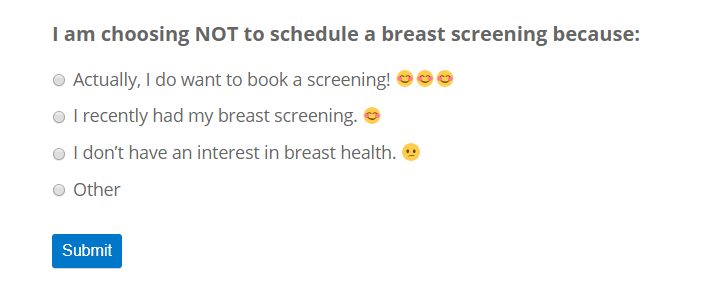Lirio, The Behavior Change Company, delivers results by drawing insights from hundreds of behavioral biases and theories. Our Bias Brief series walks through specific biases one by one, each thoughtfully selected from our long list of insights. Read on for a brief rundown on the chosen bias, complete with examples and instructions for putting it into action to help your audience do better.
Bias #149: Omission Bias; 4-minute read
Defined:
Omission Bias: The preference for harm caused by omissions over equal or lesser harm caused by acts.1
Described:
Which is worse?
- Getting vaccinated against a disease and dying from the vaccine’s side effects.
- Skipping the vaccination and dying from the disease.
The two choices have the same horrible outcome—death. And yet somehow, option one seems worse.
If you get vaccinated and die, it’s like you contributed to your death. But, if you skip the vaccine and die, it’s like the disease is to blame. That difference illustrates the cognitive distortion produced by omission bias, which tends to interfere with healthcare engagement.
One study found that parents who did not vaccinate their children feared that vaccinating was more dangerous than not vaccinating, even though the risks from the vaccination were lower than risks from the disease.2 This shows that omission bias can cause people to make irrational decisions rather than appropriately weighing the odds of each potential outcome.
Using omission bias for good:
The best way to convey how omission bias can be used for good is through a first-hand example:
Lirio created an email campaign for a hospital system in the Northeast to encourage more women to get regular mammograms. We carefully designed the call-to-action (CTA) to avoid the negative influence of omission bias.
Most email campaigns offer a single CTA button, e.g. “Schedule Your Appointment.” But presenting only one button treats the failure to schedule an appointment as an act of omission—a “non-action” for which the reader feels less responsible.
To make recipients more accountable for their choice, Lirio’s emails contained two CTA buttons: “Yes, I’m in.” and “No, I’ll wait.” This made either choice an act of commission.

The two buttons led to separate landing pages. If a recipient clicked “Yes, I’m in.” they were given a phone number to schedule an appointment. If they clicked “No, I’ll wait.” they were given multiple options—they could reconsider and click to schedule a mammogram, let us know they’d already had a recent mammogram, say they weren’t interested in cancer prevention, or provide some other reason for opting out.
Emoticons communicated injunctive norms (behaviors seen as being approved by others).

Out of 199,565 emails delivered, the campaign generated 55,451 unique opens and 4,267 clicks, resulting in 435 inbound calls and 131 confirmed appointments. Perhaps the most interesting insight was the value the “No” button added to the campaign.
After initially clicking “No,” a total of 47 women changed their mind and selected “Actually, I do want to book a screening.” By framing the decision to skip a mammogram as an act of commission, Lirio’s approach changed women’s attitudes and persuaded many to schedule screenings they otherwise might have skipped!
The takeaway:
Omission bias can often lead people to make the wrong choices when it comes to healthcare. However, using choice architecture to design the way alternatives are presented can leverage omission bias to drive better decisions. Avoid messages where the least desirable alternative can be selected by omission by looking for ways to make every alternative an active choice.
About the author:
This Bias Brief was written by Greg Stielstra, the Senior Director of Behavioral Science at Lirio. Greg is a behavior change expert and published author with over 25 years of experience in marketing and engagement.
References:
- Baron, Jonathan, and Ilana Ritov. “Omission Bias, Individual Differences, and Normality.” University of Pennsylvania School of Arts and Sciences, Elsevier.
- Asch, David A, et al. “Omission Bias and Pertussis Vaccination.” Journal of Research in Crime and Delinquency.
Other readers viewed:
Rationally Healthy: Overcoming Ourselves To Feel Our Best – The Behavior Change Podcast
Commitment & Consistency – Lirio Bias Brief
